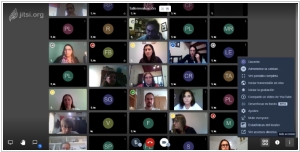Jitsi vs Pexip
March 10, 2025 | Author: Adam Levine
9★
Multi-platform open-source video conferencing. Whether you want to build your own massively multi-user video conference client, or use ours, all our tools are 100% free, open source, and WebRTC compatible.
7★
The video technology platform that powers everything from ultra secure government meetings, to personalized banking, to efficient hands-free work.
Jitsi and Pexip are two very different beasts, both plodding along the vast galaxy of video conferencing, offering surprisingly similar functions. They both enable you to look at your colleague’s face and hear their voice from the other side of the world, with quality that might make you forget you're actually talking through the ether. They both scale effortlessly, integrate with other systems and happily exist in the cloud. All in all, they’re like the Vogon ships of communication, only without the poetry.
Jitsi, in all its open-source glory, first hails from France, circa 2003. It’s the kind of solution that invites all and sundry to use and tweak at will, making it the darling of small-to-medium-sized enterprises and hobbyists alike. You’ll find yourself setting up WebRTC-powered calls and if you don’t have fancy hardware, that’s just fine. Jitsi thrives on simplicity and the joy of self-hosting, giving you all the video conferencing you could ask for, for the low, low price of nothing.
Pexip, on the other hand, is a commercial powerhouse born in Norway in 2012 and it’s not shy about its enterprise ambitions. Its focus is large organizations, those that want to make their video calls seamlessly interoperate with everything from legacy systems to the most futuristic cloud environments. With a heavy emphasis on security and compliance, Pexip makes sure your meetings are not only efficient but also secure. If you’re after a solution that’s robust enough to handle vast corporate empires, Pexip is your starship.
See also: Top 10 Videoconferencing software
Jitsi, in all its open-source glory, first hails from France, circa 2003. It’s the kind of solution that invites all and sundry to use and tweak at will, making it the darling of small-to-medium-sized enterprises and hobbyists alike. You’ll find yourself setting up WebRTC-powered calls and if you don’t have fancy hardware, that’s just fine. Jitsi thrives on simplicity and the joy of self-hosting, giving you all the video conferencing you could ask for, for the low, low price of nothing.
Pexip, on the other hand, is a commercial powerhouse born in Norway in 2012 and it’s not shy about its enterprise ambitions. Its focus is large organizations, those that want to make their video calls seamlessly interoperate with everything from legacy systems to the most futuristic cloud environments. With a heavy emphasis on security and compliance, Pexip makes sure your meetings are not only efficient but also secure. If you’re after a solution that’s robust enough to handle vast corporate empires, Pexip is your starship.
See also: Top 10 Videoconferencing software





